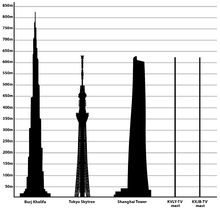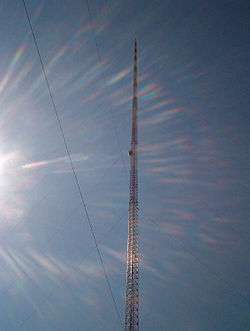KVLY-TV mast
| KVLY-TV mast | |
|---|---|
 KVLY-TV mast | |
| General information | |
| Type | TV transmission tower |
| Location | Blanchard, Traill County, North Dakota |
| Coordinates | 47°20′32″N 97°17′21″W / 47.34222°N 97.28917°WCoordinates: 47°20′32″N 97°17′21″W / 47.34222°N 97.28917°W |
| Completed | August 13, 1963 |
| Owner | Gray Television |
| Height | 628.8 m (2,063 ft) |
| Design and construction | |
| Architect | Hamilton Directors |
| Main contractor | Kline Iron and Steel |

The KVLY-TV mast (formerly the KTHI-TV mast) is a 2,063 ft (628.8 m) tall television-transmitting mast in Blanchard, Traill County, North Dakota, United States, used by Fargo station KVLY-TV channel 11. Completed in 1963, it was the tallest structure in the world until succeeded by the Warsaw radio mast in 1974; that mast collapsed in 1991, making the KVLY-TV mast again the tallest structure in the world until the Burj Khalifa overtook it in 2010. It remains the fourth-tallest structure in the world (since the construction of the Tokyo Skytree and the Shanghai Tower), the tallest structure in the western hemisphere, and the tallest radio mast in the world.
It is a guyed mast, not a self-supporting structure, and is therefore not included in lists of tallest buildings or list of tallest towers.
Location

The mast is located 3 miles (4.8 km) west of Blanchard, North Dakota, halfway between Fargo and Grand Forks. It became the tallest artificial structure, and the first man-made structure to exceed 2,000 feet (610 m) in height, upon the completion of its construction on August 13, 1963.
Construction
The tower was built by Hamilton Erection Company of York, South Carolina and Kline Iron and Steel, and took thirty days to complete, at a cost of US$500,000 (worth $3,871,196 today).
Owners
Owned by Gray Television of Atlanta, Georgia, the tower broadcasts at 356 kW on channel 44 for television station KVLY-TV (channel 11 PSIP, an NBC/CBS affiliate) which is based in Fargo. The tower provides a broadcast area of roughly 9,700 sq mi (25,000 km2) which is a radius of about 55.6 miles (89.5 km).
When the mast was built the call letters of the television station for which it was built were changed to KTHI, the "HI" referring to the height of the mast. The top is reachable by a two-person service elevator or ladder.
Specifications
The tower consists of two parts: a lattice tower of 1,950 feet (590 m);[1] topped by a transmitting array of 113 feet (34 m). The total height of both is 2,063 ft (628.8 m). The antenna weighs 9,000 pounds (4.3 tons; 4,300 kg), the lattice tower weighs 855,500 pounds (388 tons; 388,000 kg), giving a total weight of 864,500 pounds (392 tons; 392,100 kg). It takes up 160 acres (0.65 km2) of land with its guy anchors.[2][3] Its height above mean sea level is 3,038 ft (926 m).
Federal rule change
Some time after its completion, the Federal Communications Commission (FCC) and Federal Aviation Administration (FAA) imposed a policy that states, "Although there is no absolute height limit for antenna towers, both agencies have established a rebuttable presumption against structures over 2,000 feet above ground level."[4] The FCC and FAA may approve a taller structure in "exceptional cases."
Images
 KVLY tower from a distance of about one mile (1.6 km)
KVLY tower from a distance of about one mile (1.6 km) Base of the tower
Base of the tower A guy-wire anchor
A guy-wire anchor Detail of the tower, showing its network of guy-wires
Detail of the tower, showing its network of guy-wires Some of the guy-wires that support the tower (with Stockbridge dampers)
Some of the guy-wires that support the tower (with Stockbridge dampers)
Structures of similar height
- KRDK-TV mast (2060 ft - 627.8 m)
- KXTV/KOVR Tower (2049 ft - 624.5 m)
See also
References
- ↑ "N.D. TV Tower No Longer World's Tallest". All Things Considered. NPR.org. 5 January 2010. Retrieved 2011-12-06.
- ↑ "KVLY-TV Tower". Emporis. Retrieved 2011-12-06.
- ↑ "Info". Valleynewslive.com. Archived from the original on August 6, 2010.
- ↑ "Antenna Tower Lighting and Marking Requirements". Federal Communications Commission. Retrieved 2011-12-06.
External links
| Wikimedia Commons has media related to KVLY-TV mast. |
- KVLY Tower at Structurae
- Tower web page at KVLY-TV
- "Listing 1046244". Antenna Structure Registration database. U.S. Federal Communications Commission.
- Listing on the Skyscraper Page
- Drawings of KVLY/KTHI TV Mast from the Skyscraper Page
- KVLY and KXJB Towers from PBPhase.com
- Video of the KVLY Tower, summer 2009 from YouTube
| Records | ||
|---|---|---|
| Preceded by WIMZ-FM-Tower |
World's tallest structure 2,063 ft (628.8 m) 1963–1974 |
Succeeded by Warsaw radio mast |
| Preceded by Warsaw radio mast |
1991–2008 |
Succeeded by Burj Khalifa |